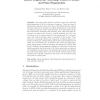Free Online Productivity Tools
i2Speak
i2Symbol
i2OCR
iTex2Img
iWeb2Print
iWeb2Shot
i2Type
iPdf2Split
iPdf2Merge
i2Bopomofo
i2Arabic
i2Style
i2Image
i2PDF
iLatex2Rtf
Sci2ools
ICB
2009
Springer
2009
Springer
Latent Fingerprint Matching: Fusion of Rolled and Plain Fingerprints
Law enforcement agencies routinely collect both rolled and plain fingerprints of all the ten fingers of suspects. These two types of fingerprints complement each other, since rolled fingerprints are of larger size and contain more minutiae, and plain fingerprints are less affected by distortion and have clearer ridge structure. It is widely known in the law enforcement community that searching both rolled and plain fingerprints can improve the accuracy of latent matching, but, this does not appear to be a common practice in law enforcement. To our knowledge, only rank level fusion option is provided by the vendors. There has been no systematic study and comparison of different fusion techniques. In this paper, multiple fusion approaches at three different levels (rank, score and feature) are proposed to fuse rolled and plain fingerprints. Experimental results in searching 230 latents in the ELFT-EFS Public Challenge Dataset against a database of 4,180 pairs of rolled and plai...
| Added | 26 May 2010 |
| Updated | 26 May 2010 |
| Type | Conference |
| Year | 2009 |
| Where | ICB |
| Authors | Jianjiang Feng, Soweon Yoon, Anil K. Jain |
Comments (0)

